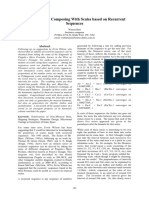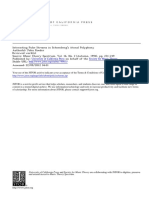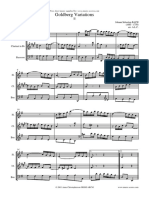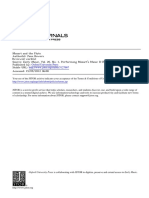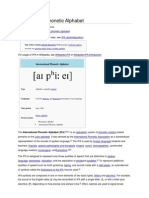Sequenza I For Solo Flute by Berio Riccorenze For Wind Quintet by Berio Rendering by Berio
Sequenza I For Solo Flute by Berio Riccorenze For Wind Quintet by Berio Rendering by Berio
Uploaded by
Zacharias TarpagkosCopyright:
Available Formats
Sequenza I For Solo Flute by Berio Riccorenze For Wind Quintet by Berio Rendering by Berio
Sequenza I For Solo Flute by Berio Riccorenze For Wind Quintet by Berio Rendering by Berio
Uploaded by
Zacharias TarpagkosOriginal Title
Copyright
Available Formats
Share this document
Did you find this document useful?
Is this content inappropriate?
Copyright:
Available Formats
Sequenza I For Solo Flute by Berio Riccorenze For Wind Quintet by Berio Rendering by Berio
Sequenza I For Solo Flute by Berio Riccorenze For Wind Quintet by Berio Rendering by Berio
Uploaded by
Zacharias TarpagkosCopyright:
Available Formats
Only Connect...
Sequenza I for Solo Flute by Berio; Riccorenze for Wind Quintet by Berio; Rendering by
Berio
Review by: David Osmond-Smith
The Musical Times, Vol. 134, No. 1800 (Feb., 1993), pp. 80-81
Published by: Musical Times Publications Ltd.
Stable URL: http://www.jstor.org/stable/1002409 .
Accessed: 15/09/2012 16:08
Your use of the JSTOR archive indicates your acceptance of the Terms & Conditions of Use, available at .
http://www.jstor.org/page/info/about/policies/terms.jsp
.
JSTOR is a not-for-profit service that helps scholars, researchers, and students discover, use, and build upon a wide range of
content in a trusted digital archive. We use information technology and tools to increase productivity and facilitate new forms
of scholarship. For more information about JSTOR, please contact support@jstor.org.
Musical Times Publications Ltd. is collaborating with JSTOR to digitize, preserve and extend access to The
Musical Times.
http://www.jstor.org
Music reviews
ONLY
David
CONNECT...
Osmond-Smith
on
recent
Berio
It
is a telling coincidence that the new score of Berio's
Sequenza I for solo flute should become available within a
few months of the death of the man for whom it was written.
Through long association with the Darmstadt summer schools,
Severino Gazzelloni became the catalyst for a distinctive style of
flute-writing - elegant, quixotic and sensual - that crystallised
into exemplary form in Sequenza I. The original 1958 version of
this score was presented in proportionalnotation and published
in this form by Suvini Zerboni. Based on a temporal grid,
against which Berio could plot fluid rhythms with accuracy, it
challenged Gazzelloni to create apparentspontaneity out of disciplined score-reading.
Unfortunately, not all of the many flautists who subsequently
took up the work have fully grasped that challenge. Some,
indeed, have imagined that proportionalnotation was an inivitation to quasi-improvisatoryrubato. Berio has therefore rewritten
the score in conventional notation - a version recently published
by Universal Edition. It makes for vivid reading: the music leaps
LUCIANOBERIO: POLEMICIST
OF THE INCOMPLETEPhoto Universal Edition
80
The
Musical
scores
off the page in a way that the less conventional Suvini Zerboni
score does not suggest. Yet there is a price to be paid. The fluid
spring of the original resolves into simpler relationships, often
suggesting an underlying quaver or crotchet pulse for a few
seconds. The conventional use of beams to join smaller rhythmic
units into quaver and crotchet groups encourages a very different
view of structuralpriorities within the phrase. It would be interesting to hear performancesfrom the two notations side by side:
I think one could tell them apart.
Subsequent Sequenzas have revealed the range of Berio's
imaginative sympathy for wind players (he was after all himself
a clarinetist during his student days), but only recently has he
turned his attention to wind ensembles. And it is precisely considerations of ensemble that predominatein Ricorrenze for wind
quintet (1985-87): even though the members of the quintet are
spaced at least two metres apart, the flamboyant writing of the
Sequenzas is here held in check. Individual melodic strandsleap
between instruments,often clouded for a moment by heterophonic interaction. As in so many of Berio's recent works, the
background pace is set by a gradual evolution in harmonic
resources. It is spare, sophisticated writing, well aware of the
wind quintet's backgroundin diversion, and a far cry from the d
rebours approachto the medium adoptedby Schoenberg.
Although Berio has often showed his skill as an orchestrator,
Rendering (1988-90) takes up the more complex issue of how
we respond to composers' sketches: in this instance the
Symphony in D major D.936A upon which Schubert was
working during the final weeks of his life. In calculated opposition to those musicologists who propose to 'complete' unfinished
works by an exercise in pastiche, Berio underlines the fragmentary nature of his materials. He likens his procedure to that of
modern fresco restorers who, while seeking to revive the colour
on surviving painting, make no attempt to fill in portions that
have flaked away, but instead leave them empty. The filling or
'rendering' (one of several possible meanings for his punning
title) is not however the musical equivalent of neutral plaster.
Instead, Berio creates a 'connective tissue', a dense orchestral
polyphony, always distant, always quiet, but shot through with
allusions to Schubert's late works, notably the final piano sonata,
Winterreise and the B flat majorTrio.
Schubert worked his sketches for the D major Symphony on
two, sometimes three staves. In order to allow the score reader
Times
February 1993
70
M.M.
zff--
>
1#
?p
IWOz I#?.
ifif
iff#
ff<
ff
full opportunity to explore, Universal Edition have printed
Schubert's often skeletal original below Berio's realisation.
Berio adopts the same orchestralforces and instrumentalstyle as
did Schubert in the 'Unfinished' Symphony, though adding the
alien sound of the celesta to underline the advent of 'connective
tissue', where strings expand into a divisi cloud. Schubert
sketched three movements: an opening allegro, a slow movement, and a fast duple movement, presumablythe finale. All are
far from complete. Indeed, the materials for the first would seem
to consist of two alternative sketches for an exposition, and a
coda. The first exposition is abandoned as it reaches a second
theme poised between mediant minor and dominant (after the
manner of the Ninth Symphony). The second, startingfrom just
before the transition, follows the same skeletal outline as the G
major string quartet:a cadence on iii leaping straight into V for
an extended second subject that veers into IIIb and back again.
Both have the same restless air of plotting out wide tonal tensions, and Berio's realisation does not attempt to mitigate the
tentative, exploratorynatureof the sketches as they emerge from,
and resolve back into his 'rendering'.
The Andante in B minor offers a more distinctive musical
statement,lent consistency by the fact that the second group, in F
sharp minor, grows out of the bassoon countersubject to the
opening theme. With an air of quiet desolation, the opening
melody comes repeatedly to rest upon the supertonic, prompting
Berio to explore the analogy with the organ-grinder'stune from
the final song of Winterreise. Two weeks before he died,
Schubert arrangedto start counterpointlessons with the theorist,
Simon Sechter, and it is in the last movement that this new-found
enthusiasm comes fully to life. The angular melody that he
employs has an almost Slavonic character,underlined by obses-
=-70
>5i
ffsempref
Two
ff:------>=-
sive reiterations. But Schubert seems bent upon thematic integration: the first episode that follows echoes the first
movement's main theme. Here, too, one may suspect that
Schubert was weighing up alternatives. The two sketches that
make up the bulk of Berio's movement follow similar key
schemes but use different subsidiary materials. They are followed by vigorous fugal perorations (again two, again perhaps
alternative).
The provisional nature of these fragments means that one
should not take Berio's suggested parallel with the restorationof
a fresco too literally. Apart from the Andante, which at least
suggests a ternarygroup, there is no sense of overall structureto
lock each fragment into place. On the other hand, Berio's
polemic against the compulsion to complete may well strike a
chord with a generation reared less upon the concert-hall, with
its enforced concentrationupon 'whole' works, than upon indefinitely repeatable and interruptible domestic listening.
Art-lovers have long been willing to put the fragment or sketch
within a frame, and enjoy its sense of the virtual as much as - in
some instances more than - the 'complete' work that it heralds.
Berio's Rendering asserts the same possibility for music.
Berio. SequenzaIfor solo flute.
Edizione Suvini ZerbonilUniversalEdition, ?7.60.
Berio. Riccorenzefor wind quintet.
Universal Edition, ?24.75.
Berio. Rendering.
Universal Edition, ?62.10
>
ff
jyMOT/?rc~~~~~~~~~~~~ff>lt
VERSIONS OF BERIO'S FLUTE SEQUENZA. TOP: THE ORIGINAL VERSION (1958),
IN UNMETRED, PROPORTIONAL NOTATION.
BOTTOM: THE NEW VERSION (1992),
IN CONVENTIONAL
NOTATION. MUSIC EXAMPLES COPYRIGHT EDIZIONE SUVINI ZERBONI AND UNIVERSAL EDITION, REPRODUCED BY PERMISSION OF UNIVERSAL EDITION
February 1993
The
Musical
Times
81
You might also like
- David Roesner "Eraritjaritjaka - and - The - Intermediality" - oNo ratings yetDavid Roesner "Eraritjaritjaka - and - The - Intermediality" - o11 pages
- Just Intonation Guitar Chord Atlas by Doty100% (1)Just Intonation Guitar Chord Atlas by Doty26 pages
- Rhythm As Motion Discovered: Javier AlvarezNo ratings yetRhythm As Motion Discovered: Javier Alvarez29 pages
- The Hotteterre Flute Six Replicas in Search of A Myth100% (2)The Hotteterre Flute Six Replicas in Search of A Myth39 pages
- In Search of The Baroque Flute The Flute Family 1680-1750100% (1)In Search of The Baroque Flute The Flute Family 1680-175015 pages
- The Evolution of A Memeplex in Late Moza PDFNo ratings yetThe Evolution of A Memeplex in Late Moza PDF42 pages
- Integrating Analytical Elements Through Transpositional Combination in Two ... Crumb100% (1)Integrating Analytical Elements Through Transpositional Combination in Two ... Crumb93 pages
- All-Combinatorial Hexachords, by Jody Nagel, Combinatoriality, All-Combinatoriality, Twelve-Tone Music, Serial MusicNo ratings yetAll-Combinatorial Hexachords, by Jody Nagel, Combinatoriality, All-Combinatoriality, Twelve-Tone Music, Serial Music6 pages
- Between Worlds Reflections On Ritual in The Music of Giacinto ScelsiNo ratings yetBetween Worlds Reflections On Ritual in The Music of Giacinto Scelsi23 pages
- Ferneyhough - The Tactility of Time (Darmstadt Lecture 1988) (Perps NM, 1993)No ratings yetFerneyhough - The Tactility of Time (Darmstadt Lecture 1988) (Perps NM, 1993)12 pages
- A Guide To James Dillon's Music - Music - The GuardianNo ratings yetA Guide To James Dillon's Music - Music - The Guardian3 pages
- Analysis of Witold Lutoslawskis Sacher V PDF100% (1)Analysis of Witold Lutoslawskis Sacher V PDF13 pages
- Interpretation and Computer Assistance in John Cage'S Concert For Piano and ORCHESTRA (1957-58)No ratings yetInterpretation and Computer Assistance in John Cage'S Concert For Piano and ORCHESTRA (1957-58)10 pages
- 2016microtonally Extended Just Intonation1No ratings yet2016microtonally Extended Just Intonation111 pages
- Practicalities of A Socio-Musical UtopiaNo ratings yetPracticalities of A Socio-Musical Utopia13 pages
- Interview With Stuart Saunders Smith and Sylvia Smith Notations 21No ratings yetInterview With Stuart Saunders Smith and Sylvia Smith Notations 2110 pages
- Interacting Pulse Streams in Schoenberg's Atonal Polyphony100% (1)Interacting Pulse Streams in Schoenberg's Atonal Polyphony20 pages
- Elements of Serialism in The Music of Thomas AdèsNo ratings yetElements of Serialism in The Music of Thomas Adès2 pages
- An Analysis and Performance Guide of Olivier Messiaen - S Chants deNo ratings yetAn Analysis and Performance Guide of Olivier Messiaen - S Chants de146 pages
- Harp - Range of Hand Positions - Orchestration OnlineNo ratings yetHarp - Range of Hand Positions - Orchestration Online2 pages
- Bennett, Bruce Christian. Notes On Luciano Berio's Thema (Omaggio A Joyce) (1958) and Visage (1961) .No ratings yetBennett, Bruce Christian. Notes On Luciano Berio's Thema (Omaggio A Joyce) (1958) and Visage (1961) .8 pages
- Analysis of Tonal Allusions in LachenmanNo ratings yetAnalysis of Tonal Allusions in Lachenman5 pages
- Ton de Leeuw Music of The Twentieth CenturyNo ratings yetTon de Leeuw Music of The Twentieth Century17 pages
- Carpenter - Grundgestalt As Tonal Function100% (1)Carpenter - Grundgestalt As Tonal Function25 pages
- Alfred Schnittke - Sonata For Cello and PianoNo ratings yetAlfred Schnittke - Sonata For Cello and Piano2 pages
- An Introduction To 20th Century Art MusicNo ratings yetAn Introduction To 20th Century Art Music3 pages
- Complete Download (Ebook) Ruth Crawford Seeger's Worlds: Innovation and Tradition in Twentieth-Century American Music (Eastman Studies in Music) by Ray Allen ISBN 9781580462129, 9781580466851, 158046212X, 1580466850 PDF All Chapters100% (3)Complete Download (Ebook) Ruth Crawford Seeger's Worlds: Innovation and Tradition in Twentieth-Century American Music (Eastman Studies in Music) by Ray Allen ISBN 9781580462129, 9781580466851, 158046212X, 1580466850 PDF All Chapters71 pages
- An Eclectic Analysis of György Ligeti's "Chromatische Phantasie (1956) " For Solo PianoNo ratings yetAn Eclectic Analysis of György Ligeti's "Chromatische Phantasie (1956) " For Solo Piano14 pages
- An Unusual Effect in The Canon Per Tonos From J. S. Bach's Musical OfferingNo ratings yetAn Unusual Effect in The Canon Per Tonos From J. S. Bach's Musical Offering14 pages
- Pierrot Lunaire and The Resistance To Theory100% (1)Pierrot Lunaire and The Resistance To Theory6 pages
- About Pierrot Lunaire. The Impressions Made On Various Audiences by A Novel Work100% (1)About Pierrot Lunaire. The Impressions Made On Various Audiences by A Novel Work11 pages
- Na..Kan (Nakan Flute) and Oral Transmission Cohesion and MusicalityNo ratings yetNa..Kan (Nakan Flute) and Oral Transmission Cohesion and Musicality20 pages
- Inherited Sound Images Native American Exoticism in Aaron Copland's Duo For Flute andNo ratings yetInherited Sound Images Native American Exoticism in Aaron Copland's Duo For Flute and29 pages
- The Reed-Flute Ensembles of South Africa A Study in South African Native MusicNo ratings yetThe Reed-Flute Ensembles of South Africa A Study in South African Native Music86 pages
- SEMINAR Past Tenses in English LanguageNo ratings yetSEMINAR Past Tenses in English Language10 pages
- Verbs II Multi-Word Lexical Verbs 1 Multi-Word Verbs: Structure and MeaningNo ratings yetVerbs II Multi-Word Lexical Verbs 1 Multi-Word Verbs: Structure and Meaning12 pages
- Materials For A Comparative Grammar of The Dene-Caucasian (Sino-Caucasian) LanguagesNo ratings yetMaterials For A Comparative Grammar of The Dene-Caucasian (Sino-Caucasian) Languages74 pages
- Comparative Analysis of The Numeral Classifiers of Bodo, Rabha and Kokborok LanguagesNo ratings yetComparative Analysis of The Numeral Classifiers of Bodo, Rabha and Kokborok Languages10 pages
- Active and Passive Voice Present Continuous Grammar67% (3)Active and Passive Voice Present Continuous Grammar4 pages


























